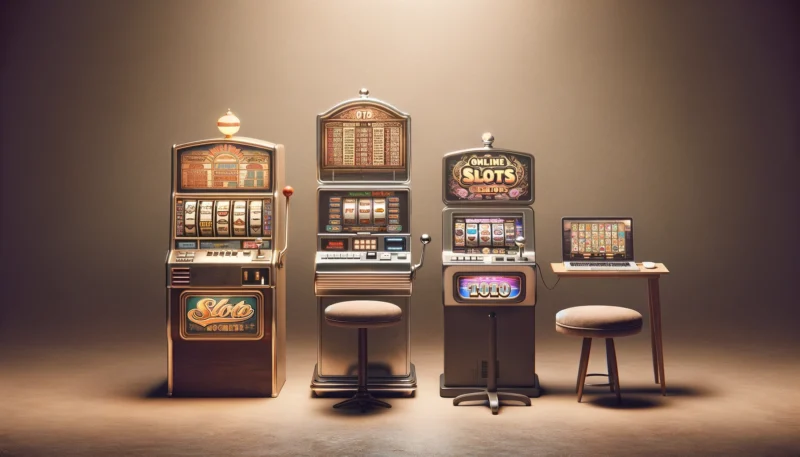Slot machines have captivated gamblers for over a century, evolving from simple mechanical devices to complex digital platforms. This evolution mirrors technological advancements and changing player preferences, making slot machines a fascinating case study in the world of gaming.
The Early Days ─ Mechanical Slot Machines
The story of slot machines begins in the late 19th century. The first true slot machine was invented by Charles Fey in San Francisco in 1895. Known as the Liberty Bell, this mechanical marvel featured three spinning reels adorned with five symbols: hearts, diamonds, spades, horseshoes, and the Liberty Bell.
The game was straightforward – players would insert a coin, pull a lever, and hope for matching symbols to line up, indicating a win. The Liberty Bell’s simplicity and the excitement of winning small prizes made it an instant hit, laying the groundwork for the slot machine industry.
The Electromechanical Era
The next significant leap in the evolution of slot online machines came in the 1960s with the introduction of electromechanical slots. These machines combined traditional mechanical components with electrical elements, allowing for more features and greater reliability. Bally Manufacturing was a pioneer in this era, producing the first fully electromechanical slot machine, the Money Honey, in 1963.
The Rise of Video Slots

The late 20th century marked another transformative period for slot machines with the advent of video slots. In 1976, the first video slot machine was developed by the Las Vegas-based company, Fortune Coin Co. This machine used a modified 19-inch Sony Trinitron color receiver for the display and logic boards for all slot machine functions. After initial resistance, video slots gained acceptance and were eventually approved by the Nevada State Gaming Commission.
By the 1990s, video slots had become the dominant form of slot machine in casinos worldwide. These machines featured colorful graphics, engaging animations, and themed storylines, attracting a broader audience. The inclusion of bonus rounds, free spins, and progressive jackpots further increased their popularity, making them a staple in both land-based and online casinos.
The Digital Revolution ─ Online Slots
The late 1990s and early 2000s saw the emergence of the Internet as a platform for gambling, leading to the rise of online casinos. Online slots quickly became one of the most popular offerings, thanks to their convenience and variety. Players could now enjoy their favorite slot games from the comfort of their homes, with an ever-expanding selection of titles to choose from.
Online slots retained the core mechanics of their physical counterparts but leveraged digital technology to enhance the gaming experience. High-definition graphics, immersive sound effects, and complex animations became standard features. The use of RNGs ensured fair play, while progressive jackpots linked across multiple games and platforms offered the potential for life-changing wins.
The online environment also allowed for greater experimentation with game mechanics. Developers introduced new features such as cascading reels, expanding wilds, and multi-level bonus games, pushing the boundaries of what slot games could offer. Mobile technology further revolutionized the industry, enabling players to access slot games on their smartphones and tablets, anytime and anywhere.
The Future of Slot Machines ─ Virtual Reality and Beyond

As technology continues to advance, the future of slot machines looks more exciting than ever. Virtual reality (VR) and augmented reality (AR) are poised to take the gaming experience to new heights. VR slots immerse players in fully interactive 3D environments, allowing them to explore virtual casinos and interact with games in a more engaging way. AR technology can overlay digital elements onto the real world, creating a blended gaming experience that bridges the gap between physical and digital play.
Artificial intelligence (AI) is another area with significant potential. AI can be used to personalize the gaming experience, analyzing player behavior to suggest games and features that match their preferences. It can also enhance game design, creating more adaptive and dynamic gameplay.
Blockchain technology is also making inroads into the gambling industry, offering increased transparency and security. Blockchain-based slots can provide provably fair gaming, where players can verify the fairness of each spin independently. Cryptocurrencies enable fast, secure, and anonymous transactions, appealing to a growing segment of the market.
Conclusion
The evolution of slot machines from mechanical reels to digital screens reflects broader trends in technology and consumer behavior. What began as a simple gambling device has transformed into a complex, immersive entertainment experience enjoyed by millions worldwide.
As we look to the future, innovations in VR, AR, AI, and blockchain promise to further revolutionize the industry, ensuring that slot machines will continue to captivate and entertain players for years to come.


